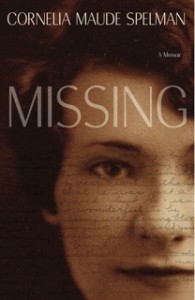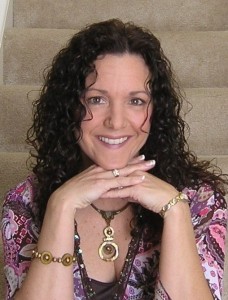Yesterday I reviewed Missing, a memoir by author Cornelia Maude Spelman. In Missing, Spelman talks about her quest to know about her mother. Today, I’m happy to feature an essay from Spelman about discovering our emotional legacies. In particular, she focuses on the mother-daughter relationship.
I invite you to embark on a quest to understand your emotional legacy and the powerful effect of your mother’s past on your own life, and, if you are a parent, on succeeding generations.
Whether your mother is alive and you have an ongoing relationship with her or whether she has passed on, whether you love and revere her or are bitterly disappointed in her, what affected her heart-what formed her, emotionally-formed you, too.
The Importance of Your Mother’s Past
Even if you have frequent contact with your mother, you may never have stopped to think deeply about why she is the way she is. Perhaps you already know some of the reasons but you want to know more.
Your mother may not want to talk about her past. Or, if she’s no longer living, you may think you missed your chance to find out more about her. However, it is likely that you can learn more, even if she doesn’t want to talk about it, and even if she has died.
Important Stories Often Buried
The stories that were most critical in the formation of your mother are often the very ones that she has not talked about. She may not have purposely hidden them. Maybe she thought they were irrelevant to you. Or maybe they were painful and she saw no point in focusing on them.
There are also, in most families, secrets. Both kinds of stories-the ignored and the purposely hidden-are the ones that invite you, if you wish to understand the present, to become a detective of the past. I believe that it is important for our emotional health to know these stories.
How Will Understanding My Mother Help Me?
Regardless of your age, understanding your mother’s heart will help you understand yourself. Understanding yourself will help you live a happier, more aware, and free-er life, because when you become aware of how the past has affected your present, you become better able to make choices about how to be and what to do. It is like the difference between rowing your own boat or being pulled by underwater currents.
Our First Relationship
Our mother is our first relationship, and, whether we are aware of it or not, we have expectations of each new relationship that were formed in that first one with her.
What, then, was that first relationship like for you? Was it warm, affectionate, safe, pleasant, predictable, and comfortable? Was your mother happy and relaxed? Did she sing to you, play with you, smile at you, show pride in you? Was she absent, inattentive, or mostly sad? Did she disappoint you, strike you, criticize or demean you?
No mother is ever perfect, nor is any woman ever perfectly prepared to be a mother. However she was, what made her that way? What did you learn from her that you want to keep? And what did you learn from her that you want to get rid of?
What I Mean By Emotional Legacy
A legacy is a “tangible or intangible thing handed down by a predecessor,” and “a long-lasting effect of an event of process.” By “emotional legacy,” I mean your mother’s behavior, attitudes, beliefs, habits, assumptions, and reactions to important people and events in her life. I also mean specifically what you learned from her about emotions.
Why Are Emotions Important?
Did your mother expess, respect, and manage emotions? For many parents of previous generations, emotional awareness was not valued, yet we know now that emotions are very important, for many reasons:
- Emotions guide us. They are like the gauges on the dashboard of our car that give us important information about the people and situations around us.
- Emotions motivate us. If we’re angry or uncomfortable, something needs to change. If we’re scared, there’s a reason.
- Emotions help us communicate and relate to others. Love, the most pleasant emotion, brings us closer to others. But less pleasant emotions can, too. Being able to share our sadness with someone is deeply comforting. Expressing anger in non-hurtful ways can clarify differences, invite solutions, and resolve problems. Telling another that we are frightened can enlist the support and comfort that we need.
- Emotions affect our learning and our health. It’s well known that children learn best when they feel safe and are able to express their needs. This is true of adults, too, as anyone who has worked in an office full of tension knows.
- Powerful emotions that are unresolved and unexpressed, or expressed without control, can hurt us. We smoke, use drugs and alcohol, eat excessively, or are compulsive sexually in order to deny or run away from emotions. And as we know too well, uncontrolled anger results in violence.
Emotional Health
I became convinced that it is important to recognize and manage emotions because my experience as a therapist showed me that many of us are not able to. Some of us seem to be blind about what we feel, or uncertain about what to do once we do know what we feel. It’s not because there’s something wrong with us, but because we didn’t learn how.
I wrote a series of picture books for young children called “The Way I Feel” books. Parents who read the books to their children have the opportunity, if they didn’t have it as children, to learn, too. Many teenagers read the books, too, because they’re a kind of “Emotions 101.”
My interest in emotions also came from coming to see that my mother was unable to recognize or manage hers, and from my belief that if she had been able to, she would not have died as she did. My memoir, Missing, tells the story of my own journey to understand the emotional legacies in my family.
So here are some questions to think about:
- What were the most important experiences in your mother’s life?
- What couldn’t you say to your mother? What couldn’t she say to you?
- In what ways are you like your mother? In what ways are you different?
- If you could change one thing about your relationship with your mother, what would it be?
- What would you most like to know about your mother?
Cornelia Maude Spelman is a writer, an artist, and a former social worker. She is the author of picture books for children, including a series called, The Way I Feel,” which has been translated into seven languages.






